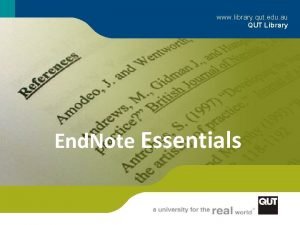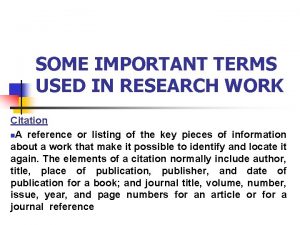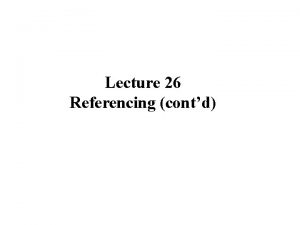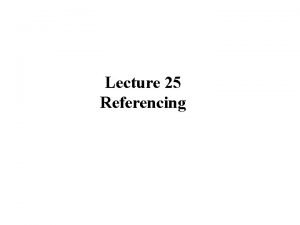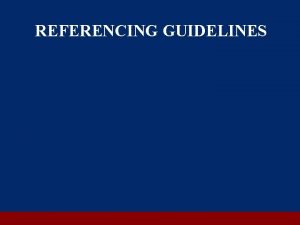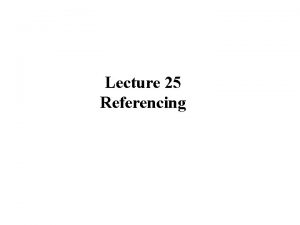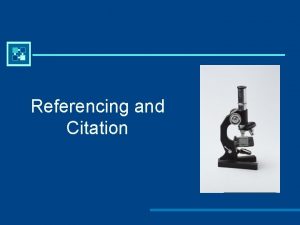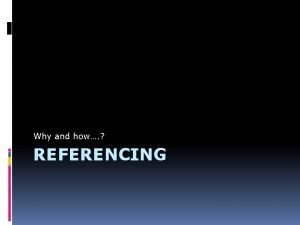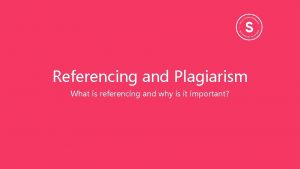Referencing What Why How What is referencing Referencing











- Slides: 11

Referencing What ? Why? How?

What is referencing? Referencing is acknowledging the source of information or ideas you have employed in your writing.

What requires referencing? • Somebody else's words or ideas from a magazine, book, newspaper, song, TV program, movie, Web page, computer program, letter, advertisement, or any other medium. • Information gained through interviewing another person. • Exact words or a "unique phrase" from somewhere. • Diagrams, illustrations, charts, and pictures. • Ideas that others have given you in conversations or over email.

Why do you need to reference? • To distinguish your own ideas from those of someone else. • To cite different points of view. • To validate what you are writing. • To integrate information by assessing, comparing, contrasting or evaluating it, to show understanding. • To emphasize a position that you agree or disagree with. • To refer to other research that leads up to your study. • To highlight a relevant point by quoting the original. • To enable readers to consult the original source independently. • You must acknowledge the source of any information to avoid plagiarism.

When do you need to reference? • When you are using or referring to somebody else's words or ideas from a magazine, book, newspaper, song, TV program, movie, Web page, computer program, letter, advertisement, or any other medium. • When you use information gained through interviewing another person. • When you copy the exact words or a "unique phrase" from somewhere. • When you reprint any diagrams, illustrations, charts, and pictures. • When you use ideas that others have given you in conversations or over email.

How do you reference? Step 1 - As you prepare for writing your essay, keep a list of all the sources you use. Example: for a book or journal you would need the following information: For a journal article: For a book: • • • Author’s Name of Book Place of Publication (city) Publisher Date of publication Edition • • Author's full name Date of publication Title of article Title of journal Volume number Issue number Page numbers Electronic database or web address (if online version was used)

How do you reference? Step 2 - Check for the referencing style you are required to use. Each Referencing style. A citation style or reference system : is a standardised system for referring to materials used in your writing • There are several different citation styles developed independently by professional organisations : § APA § Harvard § Modern Language Authority (MLA) § University of Chicago • University Departments generally stipulate which style to use for your subject.

How do you reference? Examples on citation styles: APA - Book with one author Author’s last name, First and Second Initial. (Year). Title italic. (edition). Publication location: Publishing company. Example: Coon, D. (1992). Psychology: a modular approach to mind and behavior (6 th ed. ). St Paul (MN): West Publishing. HARVARD - Book with one author AUTHOR’S LAST NAME, First and Second Initial. (Year) Title. Place of publication, Publishing company. Example: HILL, F. (1991) The Environment. Oxford, Oxford University Press.

How do you reference? Step 3 - Use bibliographic reference managing software (e. g. End. Note) End. Note allows users to: • Create a personalized database of references • Type the references or import them from a database • Create a bibliography for a thesis, assignment or journal article in the reference style required, and easily change the reference style

Citation Styles Inline styles • Brief summary of the reference in the text , e. g. author and date : [Otsu. 1980] • Full reference stated at the end of the work • Generally the full list of references will be in alphabetical order by the first author’s surname. Numbered styles • Gives reference a number in the text • Full references are listed in the bottom of the page (footnotes) or at the end of the work (endnotes) • There two styles for ordering lists : • Order list in alphabetical order and cite a reference in text with its order number in the list. • Order list in the order of citation in the text which gives reference an ascending number in the text.

Further Information q http: //www. tcd. ie/Library/support/referencing. php q http: //www. learnhigher. ac. uk q http: //www. coventry. ac. uk/caw q http: //www. cite. auckland. ac. nz q http: //www. tcd. ie/Library/support/endnote/
 Hey hey bye bye
Hey hey bye bye Dont ask why why why
Dont ask why why why Why-why analysis
Why-why analysis Why do you cry willy
Why do you cry willy Does this table represent a function why or why not
Does this table represent a function why or why not Does the table represent a function why or why not
Does the table represent a function why or why not Why or why not
Why or why not Contoh analisis akar masalah
Contoh analisis akar masalah Qut quick find
Qut quick find Citing and referencing difference
Citing and referencing difference Harvard vs vancouver
Harvard vs vancouver How to cite multiple authors
How to cite multiple authors








